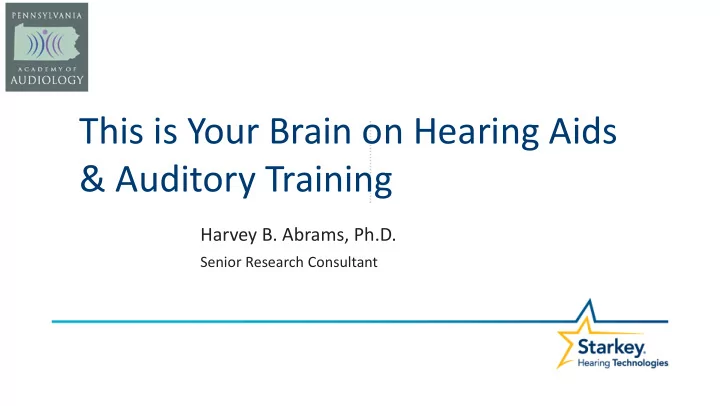

Test Measures Abbreviated Profile of Hearing Aid Benefit (APHAB) • ▫ Questionnaire design to measure amount of trouble the patient is having with communication or noises in various everyday situations Device-Oriented Subjective Outcome (DOSO) • ▫ Questionnaire designed to measure hearing aid outcomes in a way that is relatively independent of wearer personality Hearing-in-Noise Test (HINT) • ▫ 25 ten sentence lists presented in speech-shaped noise presented in an eight speaker array Words-in-Noise Test (WIN) • ▫ 35 monosyllabic word lists presented at 0, 2, 4, 8, 12, 16, 20 and 24 dB SNR based on PTA The System Usability Scale (SUS) • ▫ Ten-item Likert scale of subjective assessments of program usability Overall satisfaction/Likelihood to Recommend Questionnaire •
System Usability Scale System Usability Scale 97.5 95 95 92.5 92.5 90 87.5 87.5 77.5 72.5 70 SUS Score 60 47.5 42.5 1 2 3 4 5 6 7 8 9 10 11 12 13 14 Participant
Wear Time Daily Use % Directional % Noise %Speech in Noise RMQ 9.6 hours 19.16% 1.4 % 41.3% CTRL 8.4 hours 17.6 % 1.2 % 41.2%
Time on task Self-Reported RMQ Time 1200 1000 TOTAL MINUTES 800 600 400 200 0 1 2 3 4 5 6 7 8 9 10 11 12 13 14 15 PARTICIPANT
Subjective Measures • No differences between groups on DOSO or APHAB – Scales not sensitive to benefits achieved – Technology alone may have been sufficient for some participants • No difference between groups in overall satisfaction in, or likelihood to recommend, hearing instruments • 11 of 14 participants rated RMQ to be above average in usability – Most found it easy to use and felt confident using it
Observations • Though remotely delivered AR is convenient, compliance to a program schedule may be problematic – “Internet user” has a wide range of meaning – Patients may need technological support • Large variability in performance within groups – Suggests some individuals benefit much more than others
Selective Attention • The ability to suppress irrelevant information and focus on relevant signals in the environment • A cognitive skill of tremendous importance for everyday living and learning • We hypothesized that participants trained with RMQ will show enhanced auditory selective attention measured using ERP components (P3b and P3a) and behavioral measures
Current Study • Neurophysiological study investigating first-time HA users – Effects of amplification – Effects of auditory training • We hypothesize that participants trained with RMQ will show: – Enhanced auditory selective attention measured using ERP components (P3b and P3a) and behavioral measures
Auditory ERP in Selective Attention P3b Voluntary • • Task relevant • Increases with cognitive effort & performance P3a • Involuntary • Task irrelevant Increases with • distractor salience Polich, J.(2007)
Methodology •Before HA fitting •Four weeks after HA fitting Session 3: Training Session 1: Session 2: HA fitting Training Pretest HA posttest (4 weeks) posttest Control group: Audiobooks Experimental group: RMQ Oddball paradigm Time Dev Dis Std (Tgt) Melara, R. D., Tong, Y., & Rao, A. (2012)
Training + Amplification • Reduced P3a from pretest to training posttest found in both groups, indicating reduced distractor salience after hearing aid use (and training) • Link between changes in d' and in P3b from S2 to S3 found only in the experimental group, indicating relationship between listening performance and task-relevant attentional allocation strengthened by RMQ training
Behavioral-ERP Correlation Con Exp 1.5 d' change from S2 to S3 1.0 0.5 0.0 -0.5 P3b change in amplitude from S2 to S3 ( μ v) R = 0.1 R = 0.93**
Design • Randomized between-group, within-subjects design • Experimental and control groups • 12 participants in each group: • Experimental group (HA +RMQ) – 8 males. – Average age = 68 years (range 51 years to 84 years). • Control group (HA only) – 10 males. – Average age = 69 years (range 62 to 81 years).
Training protocol • Read My Quips – 30 minutes per day – 5 days per week – 4 consecutive weeks • All participants completed a written log – Tracked start time and end time – Difficulty level • Control group participants did not receive any structured treatment
Outcomes measured using Multimodal Lexical Sentence Test for Adults (MLST- A) • Developed by Dr. Karen Kirk and colleagues • 12 equivalent lists – 24 sentences per list • Seven to nine words per sentence • Three key words per sentence – Scores could range from 0 to 3 per sentence
MLST-A • Words controlled for lexical characteristics of frequency (how often words occur in a language) and density (number of phonemically similar words or lexical neighbors to target)
MLST – A • Five male and five female talkers • For this study, administered in AO and AV mode • Presentation Level – 60 dB SPL • Three signal-to-noise ratios (SNRs) – +5 dN – 0 dB – - 5 dB • Mode of presentation (AO vs AV) and SNR randomized for testing Total of 6 Test Conditions AO (-5 dB SNR) AO (0 dB SNR) AO (5 dB SNR) AV (-5 dB SNR) AV (0 dB SNR) AV (5 dB SNR)
Recommend
More recommend